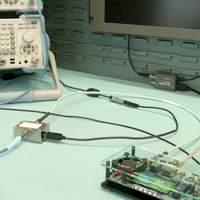End of Life Announcement
In response to the global electronics and chip shortage, we are marking LimeNET Micro as end-of-life (EOL). Your action is required if you have an open order for LimeNET Micro. Read the full update.
Supply Chain Crunch & New RF Filter Bank Demo
The global supply chain crunch has severely disrupted production of Lime products. We're still committed to bringing all Lime products back into regular availability. We're plotting a course of action and we have updated delivery estimates accordingly. In the meantime, we're excited to share a video demo of a new software-controlled frontend filter bank (a.k.a. preselector). Read the full update.
Lime Suite 20.07.1 Released
The new release of Lime Suite includes numerous improvements, along with support for the LimeRFE RF front-end and packaging for Ubuntu 20.04. Read the full update.
Timeline for Outstanding Orders
Like the rest of the world, our supply chain and standard operations have been affected by the global COVID-19 pandemic. The good news is that most outstanding orders will ship by the end of May. Read the full update.
Manufacturing Progress
A few of the parts we were planning to use went end-of-life just as we were in the process of setting up a volume production run. The good news is that we’ve identified alternative parts and updated our design to accommodate them. The new parts are due to arrive in about two weeks, and we expect to ship outstanding orders before the end of November. Read the full update.
QO-100 Satellite Uplink with LimeNET Micro and LimeRFE
Daniel Estévez paired a LimeNET Micro with a LimeRFE prototype to access the QO-100 narrowband transponder using an off-the-shelf 24 dBi Wi-Fi grid antenna. Read the full update.
High-quality Enclosure and Delivery Status
A quick peak at the LimeNET Micro aluminum enclosure and updated shipping timelines. Read the full update.
Field Report Contest
Did you do something cool with your Lime technology? Let the world know, by submitting a Field Report to us. You’ll enjoy fame and maybe even a little bit of fortune. Check out all the details in this update. Read the full update.
Shipping, Updated Case Design, and Pantahub Apps
All the LimeNET Micro board-only and Acrylic Kit packages have now been sent to Crowd Supply and should start shipping out soon. Unfortunately, there have been further delays with the aluminium case, since it required significant changes to be made as a result of the many improvements and new features that were added to the LimeNET Micro board during the campaign. Read the full update.
Shipping Delay and Compute Module Upgrade
I am happy to report that we have received the first batch of LimeNET Micro v2.1 PCBs. The plan is to assemble an initial 20 boards and conduct exhaustive tests. Read the full update.
LimeSCAN Blockchain Demo
One of the key applications for LimeNET Micro is spectrum scanning — taking power measurements and looking at spectrum utilisation, along with network availability and performance, etc. In support of this we’ve been working on an application called LimeSCAN, which allows spectrum scan data to be uploaded to a central resource and explored via a web interface. Read the full update.
Board Design Files Published
The Altium database, plus manufacturing files and schematics for the LimeNET Micro v2.0 design have now been published to the Myriad-RF GitHub. And with the campaign about to draw to a close, now is the time to pledge if you would like to take advantage of campaign pricing, which offers a $30 saving on the price of the board, along with pledge levels which include this as part of the Acrylic and Aluminium Kits. Read the full update.
Proud to be Powered by Raspberry Pi
The combination of the LMS7002M transceiver and Raspberry Pi Compute Module 3 have enabled us to create a feature packed, fully integrated SDR platform at an incredibly low cost. We’re huge fans of the Raspberry Pi platform and we are delighted to have just received approval to use the Powered by Raspberry Pi logo on the LimeNET Micro aluminium case. Read the full update.
New Bandwidth Figures
When we announced the design update which enables using USB for the host ↔ SDR interface, we changed the comparison table RF Bandwidth and Sample Rate figures to TBC, since the interface would no longer be the limiting factor and it would come down to the Raspberry Pi host. Read the full update.
More Features Added and Updated Board Renders!
The LimeNET Micro v2.0 design update has been completed and this not only includes active Power-over-Ethernet, together with Raspberry Pi Touch Screen Display and Camera connectors, but also an HDMI connector, audio out, and two USB ports instead of one. Meaning that it’s now possible to attach a full size keyboard, monitor and mouse for a full desktop configuration, in addition to being able to use LimeNET Micro to create highly compact touch screen-driven SDR appliances. Read the full update.
GSM Demo with EMF Camp Network Core
Back in August, Lime provided 16x base stations for use in creating a GSM network at the bi-annual festival for those with an inquisitive mind or an interest in making things, EMF Camp. In this video, EMF Camp’s Sam Machin gives a quick demo of a LimeNET Micro connected to the same GSM network core that was used for the event, showing a call set up between two handsets. Read the full update.
A Look at Some of The Key Features
In this short video we take a look at some of the key features of the LimeNET Micro, noting also numerous improvements that we have made to the design based on feedback since the campaign launched, which all production boards will benefit from. Read the full update.
Increased Bandwidth, Plus Camera and Display Connectors
LimeNET Micro was originally designed with narrowband applications in mind, such as GSM and various IoT air interfaces. For this reason and so as to also keep the Raspberry Pi Compute Module USB entirely free for other uses, the decision was made to use SPI bus for SDR interfacing. However, since launching the campaign we’ve received quite a few requests from users who would benefit from being able to use higher sample rates and bandwidths. Read the full update.
Thanks, OCXO, and Active PoE
A heartfelt thanks to everyone who has backed the campaign so far — with your support we reached the crowdfunding target in less than 12 hours, more than doubling it in under 24! Read the full update.
Campaign is Live
We're thrilled to announce the launch of the campaign for the latest addition to the integrated universal wireless family, the LimeNET Micro. LimeNET Micro provides fully standalone SDR at an unprecedented price point and, thanks to the combination of Lime's FPRF and the Raspberry Pi Compute Module 3, in an eminently compact form factor, with high frequency stability and accuracy, courtesy of integrated GPS and OCXO. There is a limited number of early bird (discounted) units available, so be sure to get yours right away! Read the full update.













